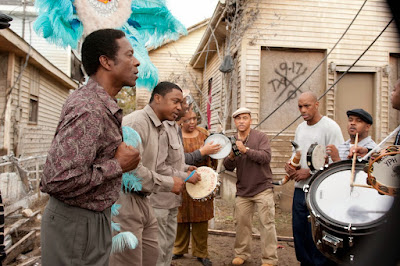High-end pay cable has always been off limits as some kind of frivolity expense, where you waste money paying for TV, of all things. For years I’ve been reading reviews about shows I’ve never seen – authoritarian shit like “24,” gangster love story “The Sopranos,” and the swear-fest “Deadwood.” Now I’ve read and seen bits of the faux-authenticity of Mad Men, the standard sad cop drama “The Wire,” breasts and blood pulp Tolkien follow-up “Game of Thrones” and the biker-thug fantasy “Sons of Anarchy.”
 |
| Mardi Gras "Indians" practice |
Faubourg Tremé is a neighborhood in New Orleans, just west of the French Quarter, across Rampart Street. It is what remains of Storyville, the neighborhood that invented jazz and was behind the development of the blues in the 1920s. (see review of “Birth of the Delta Blues,” below.) It is full of musicians, and is mostly black. The series takes place 3 months after Katrina. It is filmed in a standard Robert Altman ensemble style, following the weaving stories of Treme residents - black Indians, bar owners, restaurateurs, musicians, music-lovers, attorneys and professors – all coping with the dead water left by Katrina. While somewhat romantic and familiar, (indeed, the theme song is a knock-off of “Lovelight”) I think it captures the best parts of the city well.
Tremé pulls few punches politically or culturally. It is the first show I’ve seen on television that takes black culture seriously, as something other than lumpen or buffoonish. The portrayals attempt real people, not thugs, not saints and not comedians. One of the Mardi Gras Indians stands up to the notorious New Orleans PD. He squats in abandoned federal housing untouched by the flood so as to re-open the apartments to the black NorLins displaced from those buildings. Another story follows the mysterious death of a black youth in police custody just after the flood hit. A third tracks the life of a session trombonist trying to still make it.
Tremé, and by extension New Orleans, is a music city, and musicians are all over this series. Which is extremely rare on television. There are cameos and appearances by Steve Earle, (who actually plays a character), Allen Toussaint, Trombone Shorty, Dr. John, Kermit Ruffins, Elvis Costello, Rebirth Brass Band, Tremé Brass Band, even McCoy Tyner and Ron Carter. I’d say this is a better introduction to New Orleans jazz than the painfully sincere efforts of Ken Burns. Tremé filmed on Jackson Square among street musicians, on Frenchmen Street, and in the clubs of Rampart and others, catching the musicians in the real. Odd and knowledgeable DJ’s on the radio, Japanese jazz benefactors, second-line parades, impromptu concerts and jazz funerals punctuate the episodes.
Another theme is politics, though here the series pulls punches. John Goodman rages on ‘You Tube’ as an angry Tulane professor attacking ‘Katrina Fatigue”, NO Mayor Ray Nagin, Bush, the U.S. government, FEMA, NPR, the Po-Lice, the Army Corps of Engineers and various shit-faces. Another character, angry at the police and the city government, starts a dope-addled campaign in his ward against the slickster politicians, and gains support. One of his slogans? To legalize “Pot for Potholes.” This campaign, however, is dropped like a hot potato in Season One, albeit humorously. The Mardi Gras Indian tells his ward boss to get some housing, and when only one FEMA trailer shows up, he tells him to stuff it. Later he spends Mardi Gras in jail – a sad event for a resident of the city - for defending himself from the police. A lawyer locates a prisoner who died from blunt force trauma in police custody, but the family decides not to go further. There is little united, consistent, organized action – although you can tell the progressive population hates the ruling elite of New Orleans. After all, this is still HBO. And HBO is never going to promote mass organizing against the system.
There is even a food subtext befitting this city. Some famous New York chefs do a cameo drop-in on a local Creole restaurant run by a talented female chef at the end of her wits. I don’t know who they are, but she sure does. Another meme is how “New York” is where you go to make it. The son of the Mardi Gras Indian plays cool jazz and bebop, not New Orleans style. He’s always running between the cities, trying to escape his past. Another character claims to want to move to New York. The capital of the 10% and NO silently duel.
The trajectory of the first season is down, however. Three of the characters spiral into failure and worse. One loses a restaurant. One becomes a drug addict and drops out of music. And, in a false note, one commits suicide. The missing black youth finally turns up the way you might expect.
Would like to watch just one pay-series? It’s Tremé. Although few programs can carry themselves for years. Even Dickens ended his written serializations when the story was done. Attempting to keep a story going after it’s ‘done’ is typical of profit-based American television, which is why so many programs die a slow death. It is quite possible Tremé attempts the same thing, but here they have started with a bang.
Red Frog
January 5, 2012
No comments:
Post a Comment